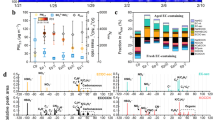Abstract
According to monitoring data, it is found that the main source of sulfates in carbonaceous particles in the atmosphere of Irkutsk is sulfur dioxide captured from the air. Their accumulation in the particles is caused by heterogeneous chemical reactions (HCRs) and is accompanied by the substitution of hydrocarbonates (\({\text{HCO}}_{3}^{ - }\)) for sulfate anions. In this case, sulfur dioxide is oxidized by ozone in the dry atmosphere, and hydrogen peroxide (H2O2), along with dissolved ozone, also participates in the oxidation process in the moist atmosphere. The details of the mechanisms for these HСRs are discussed and the estimates of the dynamics of sulphate production in carbonaceous particles are indicated.




Similar content being viewed by others
REFERENCES
F. J. Dentener, G. R. Carmichael, Y. Zhang, J. Lelieveld, and P. J. Crutzen, “Role of mineral aerosol as a reactive surface in the global troposphere,” J. Geophys. Res.: Atmos. 101, 22869–22889 (1996).
L. L. Robbins and V. J. Fabry, Carbon Dioxide Chemistry: Environmental Issues (The Royal Society of Chemistry, Cambridge, 1994).
C. R. Usher, A. E. Michel, and V. H. Grassian, “Reactions on mineral dust,” Chem. Rev. 103, 4883–4939 (2003).
Y. Mamane, E. Ganor, and A. E. Donagi, “Aerosol composition of urban and desert origin in the eastern Mediterranean, I. Individual particle analysis,” Water Air Soil Pollut. 14, 29–43 (1980).
D. L. Savoie, J. M. Prospero, and E. S. Saltzman, “Non-sea-salt sulfate and nitrate in trade wind aerosols at Barbados: Evidence for long-range transport,” J. Geophys. Res.: Atmos. 99, 5069–5080 (1989).
H. C. Zhuang, C. K. Chan, M. Fang, and A. S. Wexler, “Formation of nitrate and non-sea-salt sulfate on coarse particles,” Atmos. Environ. 33, 4223–4233 (1999).
D. Z. Zhang, G. Y. Shi, Y. Iwasaka, and M. Hu, “Mixture of sulfate and nitrate in coastal atmospheric aerosols: Individual particle studies in Qingdao (36°04′ N, 120°21′ E), China,” Atmos. Environ. 34, 2669–2679 (2000).
L. P. Golobokova, U. G. Filippova, I. I. Marinaite, O. Yu. Belozerova, A. G. Gorshkov, V. A. Obolkin, V. L. Potemkin, and T. V. Khodzher, “Chemical composition of aerosols over the Lake Baikal water area,” Opt. Atmos. Okeana 24 (3), 236–241 (2011).
V. A. Obolkin, O. G. Netsvetaeva, L. P. Golobokova, V. L. Potemkin, E. A. Zimnik, U. G. Filippova, and T. V. Khodzher, “Results of long-term investigations on acid deposition in the area of South Baikal,” Geogr. Nat. Resour. 34 (2), 151–157 (2013).
A. N. Yermakov, L. P. Golobokova, O. G. Netsvetaeva, A. E. Aloyan, V. O. Arutyunyan, and T. V. Khodzher, “On the nature of aerosol particles in the atmosphere of Irkutsk,” Izv., Atmos. Ocean. Phys. 54 (2), 162–172 (2018).
A. N. Yermakov, A. E. Aloyan, T. V. Khodzher, L. P. Golobokova, and V. O. Arutyunyan, “On the influence of atmospheric chemical reactions on the ion composition of aerosol particles in the Baikal region,” Izv., Atmos. Ocean. Phys. 43 (2), 208–218 (2007).
I. D. Eremina, A. E. Aloyan, V. O. Arutyunyan, I. K. Larin, N. E. Chubarova, and A. N. Yermakov, “Hydrocarbonates in atmospheric precipitation of Moscow: Monitoring data and analysis,” Izv., Atmos. Ocean. Phys. 53 (3), 334–342 (2017).
S. Mikkonen, S. Romakkaniemii, J. N. Smith, H. Korhonen, T. Petäjä, C. Plass-Duelmer, M. Boy, P. H. McMurry, K. E. J. Lehtinen, J. Joutsensaari, A. Hamed, R. L. Mauldin, W. Birmili, G. Spindler, F. Arnold, M. Kulmala, and A. Laaksonen, “A statistical proxy for sulphuric acid concentration,” Atmos. Chem. Phys. 11, 11319–11334 (2011).
H. A. Al-Hosney and V. H. Grassian, “Carbonic acid: An important intermediate in the surface chemistry of calcium carbonate,” J. Am. Chem. Soc. 126, 8068–8069 (2004).
L. Li, Z. M. Chen, Y. H. Zhang, T. Zhu, J. L. Li, and J. Ding, “Kinetics and mechanism of heterogeneous oxidation of sulfur dioxide by ozone on surface of calcium carbonate,” Atmos. Chem. Phys. 6, 2453–2464 (2006).
Ch. Santschi and M. J. Rossi, “Uptake of CO2, SO2, HNO3 and HCl on calcite (CaCO3) at 300 K: Mechanism and the role of adsorbed water,” J. Phys. Chem. A 110 (21), 6789–6802 (2006). https://doi.org/10.1021/jp056312b
R. A. Robinson and R. H. Stokes, Electrolyte Solutions (Butterworths, London, 1970).
S. E. Schwartz, “Mass transfer considerations pertinent to aqueous phase reaction of gases in liquid water clouds,” in Chemistry of Multiphase Atmospheric Systems (NATO ASI Series), Ed. by W. Jaeschke (Springer, Berlin, 1986), pp. 415–471.
R. D. Latterman, Calcium Carbonate Dissolution Rate in Limestone Contactors (U.S. Environmental Protection Agency, Cincinnati, Ohio, 1995).
H. Herrmann, B. Ervens, H.-W. Jacobi, R. Wolke, P. Nowacki, and R. Zellner, “CAPRAM2.3: A chemical aqueous phase radical mechanism for tropospheric chemistry,” J. Atmos. Chem. 36 (3), 231–284 (2000).
R. M. Garrels and C. L. Christ, Solutions, Minerals and Equilibria (Harper & Row, New York, 1965).
A. N. Yermakov, I. K. Larin, A. A. Ugarov, and A. P. Purmal’, “Iron catalysis of SO2 oxidation in the atmosphere,” Kinet. Catal. 44 (4), 524–537 (2003).
FUNDING
This work was supported by the Russian Foundation for Basic Research, project no. 18-05-00289, and by the State assignment to the Talroze Institute for Energy Problems of Chemical Physics of the Russian Academy of Sciences (subject AAAA-0047-2018-0012).
Author information
Authors and Affiliations
Corresponding authors
Additional information
Translated by L. Mukhortova
Rights and permissions
About this article
Cite this article
Yermakov, A.N., Aloyan, A.E. & Arutyunyan, V.O. Sulfate Sources in Carbonaceous Aerosol Particles in the Urban Atmosphere: The Case of Irkutsk. Izv. Atmos. Ocean. Phys. 55, 271–280 (2019). https://doi.org/10.1134/S0001433819020051
Received:
Revised:
Accepted:
Published:
Issue Date:
DOI: https://doi.org/10.1134/S0001433819020051




